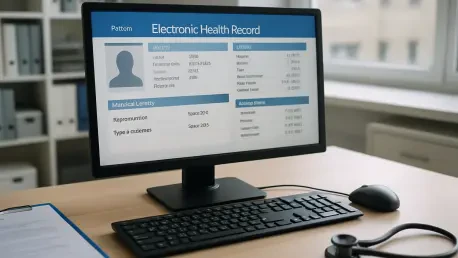In the ever-evolving world of healthcare, Electronic Health Records (EHRs) have emerged as a cornerstone of modern hospital operations across the United States, transforming the way patient care is delivered and managed. These digital systems, designed to store and organize vast amounts of medical information, are no longer just a futuristic concept but a critical tool that hospitals rely on to enhance clinical outcomes and operational efficiency. The journey of EHR adoption, particularly evident in data spanning from 2015 to 2017, showcases a remarkable shift toward data-driven healthcare, with nearly all non-federal acute care hospitals integrating these systems into their workflows. This widespread uptake, fueled by federal initiatives and technological advancements, reflects a broader commitment to improving patient safety and care quality. However, beneath this progress lies a complex landscape where disparities in resources, technology, and policy influence how effectively hospitals can harness EHR data. Exploring these dynamics reveals not only the transformative potential of digital records but also the challenges that must be addressed to ensure equitable benefits across the healthcare spectrum.
Widespread Adoption and Key Applications
The adoption of EHR systems has reached impressive heights, largely propelled by legislative efforts such as the HITECH Act of 2009, which incentivized the meaningful use of digital health records. By 2017, an overwhelming 94% of non-federal acute care hospitals reported using EHR data for at least one significant process, marking a near-universal embrace of this technology. On average, these institutions engaged in seven out of ten identified functions, demonstrating the integral role that digital records play in daily operations. The primary focus has been on enhancing core aspects of healthcare delivery, with hospitals leveraging EHR data to support initiatives that directly impact patient well-being and institutional performance. This high adoption rate underscores the success of policy-driven efforts to modernize healthcare and signals a shift toward a more connected and informed medical environment.
Among the most common applications, hospitals have prioritized using EHR data for quality improvement, patient safety monitoring, and the development of performance dashboards. These functions, adopted by over three-quarters of facilities, highlight a strategic emphasis on refining care delivery and minimizing risks. For instance, quality improvement initiatives often involve analyzing patient outcomes to identify areas for enhancement, while safety monitoring helps track adverse events and prevent errors. Despite these advancements, certain areas, such as querying data across broader networks or ensuring strict adherence to clinical guidelines, remain underutilized. This gap suggests that while the foundation for EHR use is strong, there are still opportunities to expand its scope and deepen its impact through targeted training and technological upgrades.
Disparities Across Hospital Types
Significant variations in EHR utilization exist across different types of hospitals, painting a picture of uneven progress within the healthcare sector. Larger institutions, urban-based facilities, and teaching hospitals consistently demonstrate higher engagement with EHR data, often applying it across nearly all possible functions. These hospitals typically benefit from greater financial resources, advanced infrastructure, and specialized staff, enabling them to integrate digital tools seamlessly into their operations. The ability to invest in cutting-edge systems and training programs allows such facilities to maximize the potential of EHRs, resulting in improved patient care coordination and operational oversight. This trend highlights how resource availability can create a substantial advantage in adopting and scaling digital health solutions.
In stark contrast, smaller hospitals, rural facilities, and critical access centers face persistent challenges in keeping pace with their larger counterparts. Often constrained by limited budgets, outdated technology, and staffing shortages, many of these institutions have shown little to no growth in EHR usage over the studied period from 2015 to 2017. The disparity is particularly evident in critical access hospitals, which serve remote areas and struggle with both financial and logistical barriers to implementing robust digital systems. This digital divide not only hampers their ability to improve care delivery but also risks widening existing gaps in healthcare equity. Addressing these challenges requires tailored solutions that consider the unique constraints of less-resourced facilities, ensuring that the benefits of EHRs are accessible to all.
Influence of EHR Vendors on Utilization
The choice of EHR vendor plays a pivotal role in shaping how hospitals interact with and benefit from their digital systems. Facilities using platforms developed by leading companies such as Epic and Cerner often report higher rates of engagement, particularly in complex areas like quality improvement and strategic planning. These vendors typically offer comprehensive features, user-friendly interfaces, and robust support services that facilitate broader application of EHR data. Hospitals with access to such systems are better equipped to analyze patient information, streamline workflows, and implement evidence-based practices, ultimately driving better outcomes. The influence of vendor quality underscores the importance of software design in unlocking the full potential of digital health records.
Conversely, hospitals relying on systems from lesser-known or smaller vendors frequently focus on more limited functions, such as basic patient safety monitoring, and struggle to expand their usage. These platforms may lack the advanced capabilities or technical support needed to handle diverse processes, resulting in underutilization of EHR data. Such discrepancies reveal a critical need for standardization in software functionality and vendor support to ensure that all hospitals, regardless of their chosen provider, can achieve similar levels of benefit from their digital tools. Bridging this gap could involve industry-wide efforts to enhance system compatibility and provide accessible training, leveling the playing field for institutions with varying technological partnerships.
Interoperability as a Critical Factor
The ability to share and integrate data across different systems, commonly referred to as interoperability, stands out as a game-changing element in the effective use of EHRs. Hospitals that excel in all four domains of interoperability—sending, finding, receiving, and integrating data—utilize their digital records for nearly nine out of ten identified processes. This seamless exchange of information with external systems enhances clinical decision-making, improves care coordination, and boosts operational efficiency. For example, interoperable systems allow providers to access comprehensive patient histories from multiple sources, ensuring more informed and timely interventions. The stark advantage held by hospitals with robust interoperability highlights its role as a cornerstone of modern healthcare delivery.
However, many facilities, particularly smaller or less-resourced ones, face significant barriers to achieving this level of data connectivity. Technical limitations, lack of standardization, and insufficient funding often prevent these hospitals from engaging in effective data exchange, restricting their EHR usage to just a few basic functions. This limitation not only hampers individual hospital performance but also undermines broader efforts to create a cohesive healthcare network where information flows freely. Overcoming these obstacles necessitates targeted investments in technology infrastructure and the development of universal standards that facilitate interoperability across diverse systems, ensuring that all institutions can reap the benefits of connected health data.
Role of Policy and Incentive Models
Government-driven initiatives, particularly those led by the Centers for Medicare and Medicaid Services (CMS), have proven instrumental in encouraging hospitals to maximize their use of EHR data. Participation in innovative programs such as the Bundled Payments for Care Improvement model correlates strongly with higher engagement, with participating hospitals often utilizing their systems for eight or more processes. These initiatives align EHR usage with value-based care objectives, incentivizing facilities to integrate data into workflows that prioritize patient outcomes over volume of services. The success of such programs demonstrates how strategic policy interventions can accelerate the adoption of digital tools and drive meaningful improvements in healthcare delivery.
Hospitals that do not participate in these incentive models, however, often lag behind, missing out on the full spectrum of benefits that EHR data can offer. Non-participants typically engage in fewer processes, reflecting a slower transition to data-driven practices and potentially compromising their ability to meet evolving care standards. This disparity underscores the power of policy as a motivator and suggests that expanding access to such programs could help bridge gaps in EHR utilization. Future efforts might focus on tailoring incentives to support smaller or rural hospitals, ensuring that the push toward digital transformation reaches every corner of the healthcare system and fosters a more unified approach to leveraging technology.
Evolving Trends and Future Outlook
Looking at the trajectory of EHR usage, the period from 2015 to 2016 marked a significant surge, with hospitals rapidly expanding the ways in which they applied digital data. Key areas of growth included identifying high-risk patients and addressing gaps in care, both of which are essential for advancing population health management. This rapid progress reflected a collective recognition of EHRs as vital tools for tackling pressing healthcare challenges, from preventing adverse events to ensuring continuity of care. The momentum during this time illustrated the potential for digital systems to revolutionize hospital operations when supported by strong policy frameworks and technological innovation, setting a promising foundation for further advancements.
By 2017, however, the pace of growth in EHR utilization had leveled off, indicating a possible saturation point or the need for new catalysts to inspire further expansion. Without fresh technological breakthroughs or enhanced policy support, hospitals may struggle to uncover additional applications for their data. This plateau suggests that maintaining progress will require ongoing investments in areas like interoperability standards and user training, as well as legislative efforts to address emerging needs. Looking ahead from 2025 to 2027, the focus might shift toward integrating advanced analytics and artificial intelligence with EHR systems, potentially unlocking new ways to enhance care delivery and operational efficiency across diverse hospital settings.
Harnessing Lessons for Continued Progress
Reflecting on the strides made by hospitals in using EHR data from 2015 to 2017, it’s evident that this period laid crucial groundwork for a data-driven healthcare era. The near-universal adoption of digital records, coupled with their application in improving quality and safety, showcased the profound impact of technology on patient care. Yet, the journey revealed persistent disparities, with smaller and rural facilities often left behind due to resource constraints. The influence of vendors and interoperability barriers further shaped the landscape, while policy incentives emerged as powerful tools for encouraging deeper engagement with digital systems.
Moving forward, the insights gained from this transformative phase point to actionable steps for sustaining and expanding the benefits of EHRs. Prioritizing interoperability through standardized protocols can ensure seamless data sharing, while targeted support for under-resourced hospitals could help close the digital divide. Additionally, fostering collaboration between vendors and healthcare providers might lead to more consistent software capabilities, empowering all facilities to maximize their systems. As the healthcare sector continues to evolve, these strategies offer a roadmap for ensuring that the potential of EHR data is fully realized, paving the way for a more equitable and efficient future in patient care delivery.









